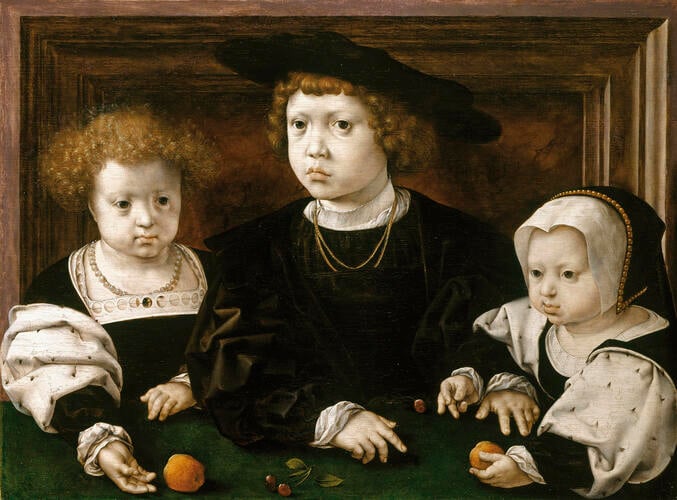-
1 of 253523 objects
The Children of Christian II, King of Denmark (1481-1559) 1526
Oil on oak panel | 34.2 x 46.2 cm (support, canvas/panel/stretcher external) | RCIN 405782
-
On 19 January 1526 Isabella of Habsburg, Queen of Denmark and sister of the Emperor Charles V, died, leaving behind her three children: John, aged 7; Dorothea, aged 5; and Christina, aged 3. This portrait was painted the same year and was perhaps commissioned in honour of the children's deceased mother; the children are shown wearing the sombre clothes of mourning, and the bloodless pallor of their faces may be an intentional device to indicate their sorrow. The children's father, King Christian II of Denmark, sent them to Mechelen to be raised by their great-aunt, Margaret of Austria, governor of the Netherlands, who had previously taken responsibility in the same manner for their uncle (The Holy Roman Emperor Charles V).
The portrait is curious. The three figures seem to be cramped into a very small space, sitting around a table with a green cloth covering. John, in the centre, looks out towards the viewer, his head at a slight angle, emphasised by the tilt of his oversized black bonnet. The two girls stare vacantly ahead as though unaware that they are being observed. The bond between the three is illustrated by their physical closeness, painted literally overlapping one another and forming a strong family unit, John’s left hand placed firmly on the table underneath the arm of his younger sister and his right sleeve obscuring Dorothea’s left arm.
The composition is an illusionistic trick. Just inside the frame across the top and along two sides of the painting is an inner fictive frame painted to look like a continuation of the real one, creating the illusion that the children project out from the frame into our space. As a favoured artist of Philip of Burgundy (illegitimate son of Philip the Good), Gossaert was well versed in courtly conceits. It was common to portray important children as though they were already adults. Here the Crown Prince seems to be taking on the role of king, with Dorothea as his queen and Christina as their child, thereby demonstrating the children’s status. The inclusion of cherries and quinces on the green table may be emblematic of a well-nurtured childhood (a metaphor suggested by Plutarch in De Liberis Educandis).
The provenance of this painting is complicated. The 1542 inventory of Henry VIII’s collection at Whitehall lists ‘…oone table with the pictures of the 3 children of the King of Denmarks… ’ This may also be the Gossaert painting referred to by Van Mander in 1604 ‘…in the Gallery at Whitehall, the heads of two young boys, children of the nobility’. If so, then the painting would appear to have been acquired by Henry VIII. The most likely moment for its acquisition would be during his marriage to Catherine of Aragon (divorced in 1533); she was great-aunt to the children depicted (their mother, Isabella of Habsburg, was the daughter of Joanna of Castile, Catherine’s sister). It remained at Whitehall during the reign of Charles I, but does not appear in the inventories of Charles II following the Restoration. It is possible that Queen Caroline (1683 – 1787), who collected historical portraits, acquired the painting when she was Consort to George II (1683 – 1760) mistakenly thinking that it depicted the children of Henry VII.
Catalogue entry adapted from Bruegel to Rubens: Masters of Flemish Painting, London, 2007 and Northern Renaissance: Durer to Holbein, London, 2011Provenance
Possibly acquired by Henry VIII; recorded in Whitehall in 1542 (no 673); still at Whitehall in the Privy Chamber in 1639 (no 60); sold from St James's Palace for £10 to Ralph Grynder and others on 23 October 1651 (no 199); recovered at the Restoration, it next surfaces in the Queen's Closet at Kensington Palace in 1732; where it is listed in 1818 (no 209) and illustrated in Pyne's Royal Residences of 1819 (RCIN 922154).
-
Creator(s)
-
Medium and techniques
Oil on oak panel
Measurements
34.2 x 46.2 cm (support, canvas/panel/stretcher external)
45.0 x 57.1 x 5.1 cm (frame, external)
Other number(s)
Alternative title(s)
The children of Henry VII, King of England, previously identified as
The children of Henry VIII, King of England, previously identified as
